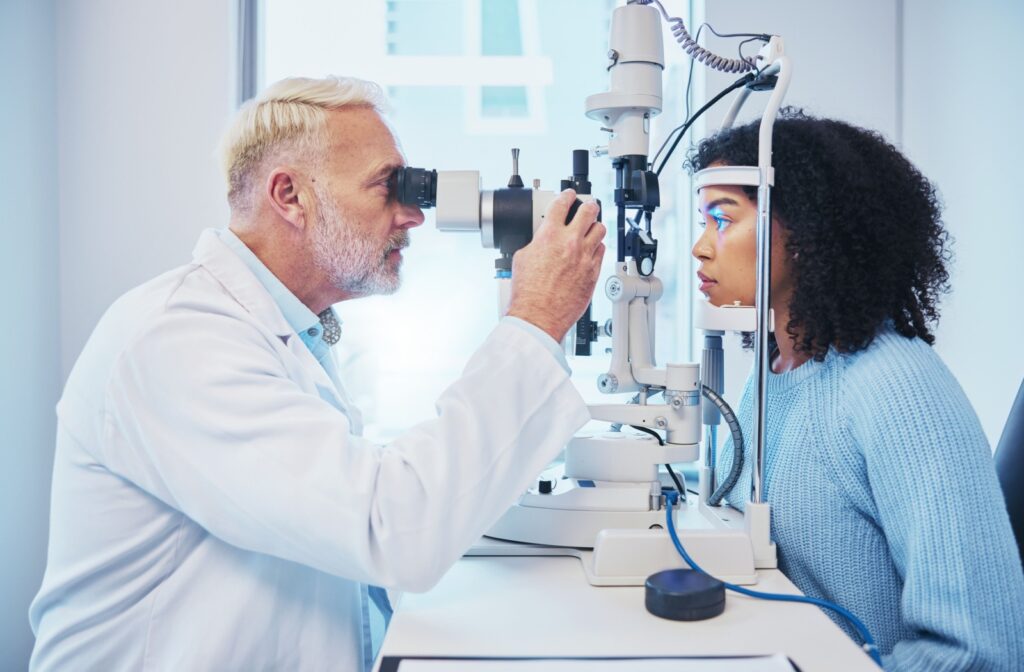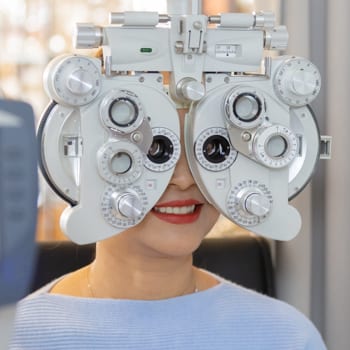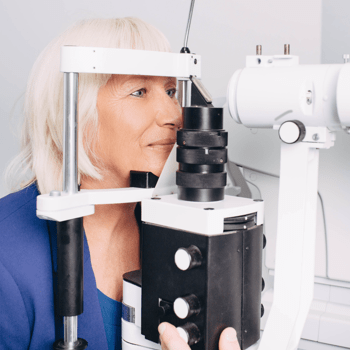Our body is an interconnected system, where a single change can affect more than one bodily function. This explains why the impact of a chronic condition, like diabetes, extends far beyond blood sugar levels.
There is a direct connection between diabetes and eye health. Through increased damage accumulation, oxidative stress, inflammation, and additional risk factors, diabetes can accelerate the onset and progression of age-related eye conditions, like:
- Presbyopia
- Cataracts
- Glaucoma
- Age-related Macular Degeneration
How Diabetes Affects Vision
Diabetes is a chronic health conditions that affect nearly 3.8 million Canadians and is related to the body’s ability to regulate and secrete insulin.
Insulin is a hormone responsible for helping glucose enter the cells to be used as energy. Without enough insulin, glucose builds up in the blood, resulting in high blood sugar levels over time.
Also known as hyperglycemia, high blood sugar levels can damage blood vessels and nerves throughout the body, including those in the eyes. This explains why diabetic changes greatly affect the eyes.
There are two main types of diabetes. And, regardless of which type someone may have, both forms can lead to diabetic-related changes, as consistently high blood sugar levels are hallmarks of this condition.
Diabetic-related Eye Changes
The delicate blood vessels in our eyes are particularly vulnerable to damage from prolonged periods of high blood sugar. Diabetes affects vision in several ways:
- Weakened blood vessels: High glucose levels can compromise the health of tiny retinal blood vessels, leading to leaks, blocks, or swelling that impair vision.
- Nerve damage: Diabetes can damage the optic nerve, which transmits visual information from the retina to the brain. Elevated blood sugar can disrupt the blood supply to the optic nerve, resulting in partial or complete vision loss.
- Inflammation: Persistent inflammation resulting from diabetes can deteriorate the overall health of the eye tissues.
Leaving diabetes unmanaged increases the risk of developing eye conditions, harming overall ocular health and vision:
- Diabetic Retinopathy: A most common complication related to diabetes, this damages retinal blood vessels through swelling, blockages, or leaks, which may lead to blurry vision, dark spots, or even impaired vision.
- Diabetic Macular Edema: A complication of diabetic retinopathy, this causes the macula, the central structure of the retina, to swell. The macula is responsible for sharp central vision, any damage to the macula can lead to distorted or loss of vision.
- Cataracts: This condition develops naturally, often as a result of growing older. It leads to clouding of the eye’s lens, causing blurry or hazy vision. People with diabetes are more likely to develop this condition and the cataracts can also progress rapidly.
- Glaucoma: Diabetes significantly increases the risk of glaucoma, a group of diseases that damage the optic nerve and can result in permanent vision loss.
Fortunately, managing diabetes can significantly reduce the risk of developing these eye conditions, but this doesn’t eliminate it entirely.

What are Age-related Eye Conditions?
Age-related eye conditions develop naturally–even in those without underlying health conditions like diabetes–as part of the aging process, although their severity can vary among patients.
- Presbyopia: The gradual loss of the eye’s ability to focus on nearby objects, requiring reading glasses. This typically becomes noticeable around age 40.
- Age-related Macular Degeneration (AMD): An eye condition that primarily affects older adults, and causes deterioration of the macula, leading to central vision loss. AMD can cause significant vision loss, particularly in activities requiring detailed sight, such as reading, driving, or recognizing faces.
- Cataracts: This develops when the lens of the eye becomes cloudy, decreasing visual clarity. This clouding prevents light from passing freely to the retina, resulting in blurred or distorted images.
- Glaucoma: A progressive condition that damages the optic nerve due to high eye pressure. It often has no symptoms until significant vision loss has occurred.
Age is a primary risk factor that contributes to the likelihood of developing these conditions, but others include:
- A family history of eye diseases
- Lifestyle habits like smoking and exposure to UV light, accelerate eye tissue damage.
- Chronic medical conditions like high blood pressure and diabetes.
How Diabetes Accelerates Age-related Eye Conditions
Having diabetes introduces increasing complexity for those who may be already vulnerable to age-related changes. Here’s how:
- Damage accumulation: The vascular damage caused by diabetes exacerbates processes associated with age-related changes. This means that people with diabetes may experience more severe vision changes at an earlier age.
- Oxidative stress: High blood sugar induces oxidative stress, accelerating cell damage in the eyes.
- Inflammation: Chronic inflammation driven by diabetes creates an environment that quickens the onset of conditions like glaucoma and AMD.
- Risk Factors: Diabetes is associated with other health conditions such as high blood pressure, which are also risk factors for developing certain eye diseases.
Through these processes, diabetes can accelerate the development of age-related eye conditions, including:
- Presbyopia: While not directly linked to diabetes, it can accelerate the onset of presbyopia. High blood sugar levels can reduce the flexibility of the lens, making it more difficult to focus.
- Cataracts: People with diabetes can develop cataracts, often years before people who don’t have this condition. Studies show that those with diabetes are up to five times more likely to develop cataracts.
The Role of Early Detection & Advanced Screening Tools
Given the increased risk of vision loss, early detection is crucial for individuals with diabetes. Traditional retinal exams remain essential, but advancements in AI-driven screening tools like RetinaLogik are improving the speed and accuracy of diabetic eye disease detection.
RetinaLogik’s portable, AI-powered assessments can help:
- Identify subtle retinal changes sooner, allowing for earlier intervention.
- Provide remote screening options, improving access to care for patients in remote or underserved areas.
- Enhance monitoring of diabetic retinopathy and macular edema, ensuring timely management before significant vision loss occurs.
Schedule an Exam
Having diabetes doesn’t necessarily mean these age-related eye conditions are inevitable, but it does increase the risk. Routine eye exams and annual diabetic eye screenings are essential for mitigating these risks.
Emerging AI-powered tools like RetinaLogik are making diabetic eye disease detection more efficient, ensuring that vision-threatening conditions are caught as early as possible.
Give our friendly team at Foresee Eyecare a call to schedule your next eye exam.



















